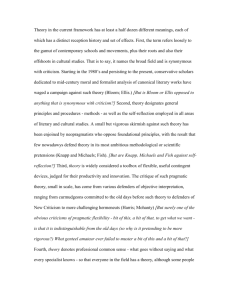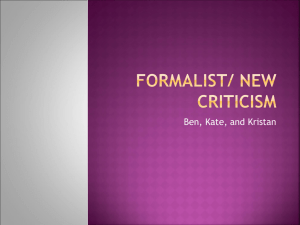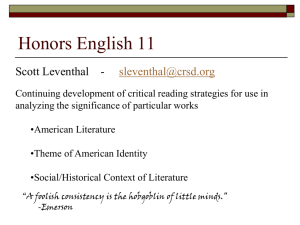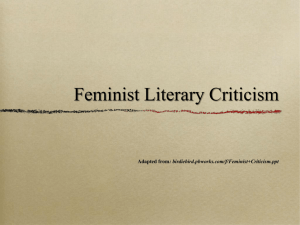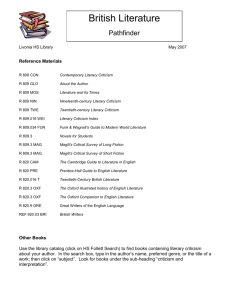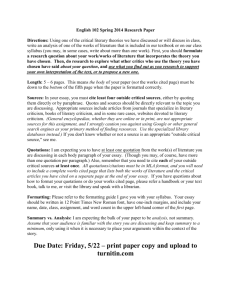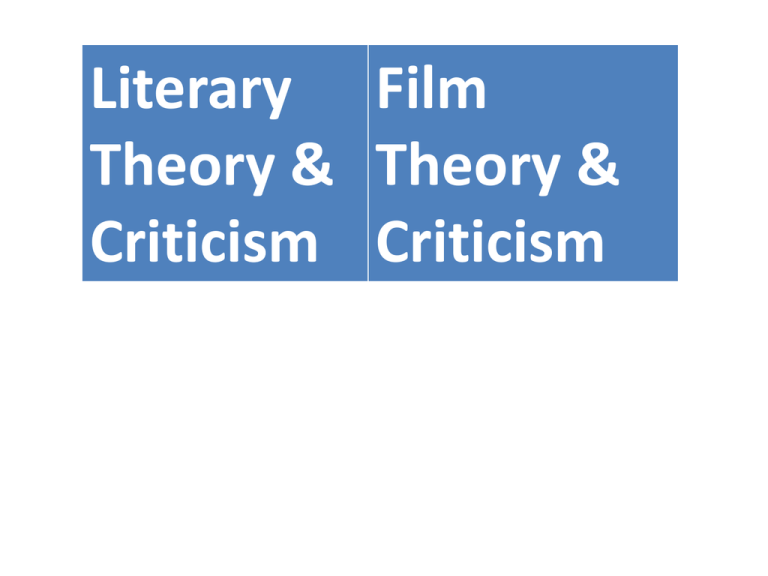
Literary Film
Theory & Theory &
Criticism Criticism
Literary Theory & Criticism
Film Theory & Criticism
no literary equivalent Auteurism
Thumbnail: Identification of the
primary signatures (thematic,
stylistic, geographical) of a given
filmmaker, customarily the director
Key Terms: signature | motif |
styleme
Important Figures: François Truffaut,
Andrew Sarris, André Bazin, John
Caughie
Literary
Theory &
Criticism
Film Theory & Criticism
No literary
equivalent
Cinematic Apparatus
Thumbnail: “[D]erived in part from Marxist film theory, semiotics,
and psychoanalysis, . . . a dominant theory within cinema studies
during the 1970s. It maintains that cinema is by nature ideological
because its mechanics of representation [including] the camera
and editing [are ideological]. The central position of the spectator
within the perspective of the composition is also ideological.
Apparatus theory also argues that cinema maintains the
dominant ideology of the culture within the viewer. Ideology is
not imposed on cinema, but is part of its nature. Apparatus
theory follows an institutional model of spectatorship.” [Adapted
from Wikipedia]
Key Terms: the cinematic apparatus | ideology | the spectator
Important Figures: Jacques Lacan, Louis Althusser, Jean-Louis
Baudry, Jean-Louis Comolli, Christian Metz, Laura Mulvey, Peter
Wollen, Constance Penley
Literary Theory & Criticism
Film Theory & Criticism
Cultural Studies
Cultural Studies
Thumbnail: Cultural studies and critical theory combine
Thumbnail: Same as for
literary theory.
sociology, literary theory, film/video studies, and cultural
anthropology to study cultural phenomena in industrial
societies. Cultural studies researchers often concentrate
on how a particular phenomenon relates to matters of
ideology, race, social class, and/or gender. Cultural studies
concerns itself with the meaning and practices of
everyday life. Cultural practices comprise the ways people
do particular things (such as watching television, or eating
out) in a given culture. Particular meanings attach to the
ways people in particular cultures do things.
Key Terms: American studies | critical legal studies |
marxist studies | media studies | popular culture |
postcolonial studies | postmodern studies | queer studies
| race studies | women's studies
Important Figures: Stuart Hall, Richard Hoggart, Raymond
Williams, Tony Bennett, Homi Bhabha, Bell Hooks, Andrew
Ross, Constance Penley, Meaghan Morris
Important Figures: Same as
those on the left.
Literary Theory & Criticism
Film Theory & Criticism
Dialogism/Bakhtinian Dialogism/Bakhtinian
Thumbnail: Examination of the
rival voices in a narrative.
Thumbnail: Same as on the left
Key Terms: carnival | chronotope
| dialogism | heteroglossia |
polyphonic
Key Terms: Same as on the left
Important Figures: Mikhail
Bakhtin
Important Figures: Robert Stam
Literary Theory & Criticism
Film Theory & Criticism
Feminist
Feminist
Thumbnail: Careful attention
to/examination of (1) the
representation of women in
literature; (2) women as authors.
Thumbnail: Careful attention
to/examination of (1) the
representation of women in film;
(2) women as filmmakers.
Key Terms: androcentric |
androgyny | cyborg | feminism |
gynocriticism | marginality |
patriarchy | phallocentrism | sexism
| écriture féminine
Key Terms: See terms on the left +
gaze | objectification
Important Figures: Julia Kristeva,
Hélène Cixous, Luce Irigaray, Gilbert
and Gubar, Eve Sedgwick,
Important Figures: Laura Mulvey,
Christine Gledhill, Kaja Silverman,
Tania Modleski, Linda Williams,
Molly Haskell, Joan Mellen, Mary
Ann Doane, Gaylyn Studlar,
Constance Penley
Literary Theory & Criticism
Film Theory & Criticism
Geneva School
Geneva School
Thumbnail: A-chronological study
of the themes exhibited in the
entire corpus of a writer.
Thumbnail: Does not really exist for
film, though has much in common
with auteurism.
Key Terms: interior distance |
phenomenology of reading |
metamorphosis of a circle |
criticism of consciousness |
deepening | prolonging | point of
departure | unit passages |
intimacy | coincidence
Important Figures: Jean
Starobinski, Georges Poulet, JeanPierre Richard, J. Hillis Miller,
Marcel Raymond
Key Figures: David Lavery
Literary Theory & Criticism
Film Theory & Criticism
Influence Theory
Influence Theory
Thumbnail: Tracking of the ways
in which an author misreads (an
act known as misprision) a
patriarchal ancestor in order to
establish a “revisionary space” for
himself/herself in literary history.
Thumbnail: Does not yet exists for
film or television but see below.
Key Terms: ancestor texts |
antithetical | belated | defensively
| ephebe | misprision | the
patriarch | revisionary space |
strong
Important Figures: Harold Bloom
Important Figures: None really, but
see David Lavery, “The Ephebe of
Television.”
Literary Theory & Criticism
Film Theory & Criticism
Marxist/Ideological
Marxist/Ideological
Thumbnail: Examination of the
economic/power context in which
a work of art comes into the
world.
Thumbnail: See the thumbnail on the
left.
Key Terms: alienation | aura |
base and superstructure | cooptation | dialectic | flaneur |
hegemony | ideology |
interpellation | materialism |
reification | slippage
Important Figures: Karl Marx,
Louis Althusser, Antonio Gramsci,
The Frankfurt School, Walter
Benjamin, Michel Foucault,
Herbert Marcuse
Important Figures: Same.
Literary Theory & Criticism
Film Theory & Criticism
Narratology
Narratology
Thumbnail: Dissection of the
storytelling process in all its forms as
well as identification of all the
possible “moving parts” that
contribute to a narrative and its
understanding.
Thumbnail: Same as the thumbnail on
the left but applied to film and television
narratives
Key Terms: act/actor | anachrony |
Key Terms: Similar to those on left.
author function | deferment |
postponement | diegesis | discourse |
double focalization | frame tale | double
voiced | enunciation | intertextuality |
intrusive narrator | mise-en-abyme |
narratee | narration | narrative |
repetition, paradigmatic | syntagmatic |
suspense | suture | self-referentiality |
antagonist ] protagonist
Important Figures: Wolfgang Iser,
Hans Robert Gauss, Vladimir Propp,
Robert Scholes, Gerard Genette
Important Figures: Seymour Chatman,
Jane Feuer
Literary Theory & Criticism
Film Theory & Criticism
New Criticism
New Criticism
Thumbnail: The systematic,
formalistic examination of a work
of literature.
Thumbnail: No real equivalent, but is
comparable to various formalistic
readings of film.
Key Terms: tension | heresy of
paraphrase | intentional fallacy |
ambiguity | irony | paradox |
close reading
Important Figures: Robert Penn
Warren, Cleanth Brooks, John
Crowe Ransom, Allen Tate,
William Empson
Important Figures: W. R. Robinson
Literary Theory & Criticism
Film Theory & Criticism
New Historicism
New Historicism
Thumbnail: The understanding,
perhaps closer to anthropology
that traditional history, of
historical texts as the product of
complex, “treacherous,” difficult
to decipher culture forces and
millieus.
Thumbnail: No real equivalent,
perhaps due to film’s recentness. But
should there be? How would it differ
from its literary equivalent?
Key Terms: deep context, thick
description
Important Figures: Stephen
Greenblatt
Important Figures: Perhaps: Geoffrey
O’Brien, Phantom Empire: Movies in
the Mind of the 20th Century
Literary Theory & Criticism
Film Theory & Criticism
Post-Colonialism
Post-Colonialism
Thumbnail: Reading the work of
“Third World” and anglophone
authors with an eye (and ear) to
the differences that underpin the
work of once dominated peoples.
Thumbnail: Viewing cinema from
nations now independent from
colonial dominance.
Key Terms: authenticity |
contamination | creolization |
double colonization | master
narrative | Eurocentric |
negritude | subaltern |
transculturation
Key Terms: all those on the left, plus
Fourth Cinema
Important Figures: Homi Bhabha,
Edward Said
Important Figures: TBA
Literary Theory & Criticism
Film Theory & Criticism
Psychoanalytic
Psychoanalytic
Thumbnail: The implementation of
psychoanalytic theory—from Freud, to
Jung, to Lacan—in order to put either
authors or characters or narratives on
the couch
Thumbnail: The implementation of
psychoanalytic theory—from Freud, to
Jung, to Lacan—in order to put not only
authors, characters, and narratives, but
the spectator, too, on the couch
Key Terms: abject | fetishism | fort/da Key Terms: See terms on left, plus: the
| imaginary/symbolic/real | other |
gaze | mirror stage
phallocentrism | pleasure | repression
| transference | unconscious | id | ego
| superego | archetypal | individuation
| sublimation | collective unconscious
| the hero’s journey
Important Figures: Sigmund Freud,
Karen Horney, Alfred Adler, C. G. Jung,
Joseph Campbell, James Hillman
Important Figures: Hugo Münsterberg
Literary Theory & Criticism
Film Theory & Criticism
Queer Theory
Queer Theory
Thumbnail: “Queer theory is a field of critical theory Thumbnail: Interpretation of filmic texts that seeks
that emerged in the early 1990s out of the fields of
LGBT studies and feminist studies. It is a kind of
interpretation devoted to queer readings of texts.
Heavily influenced by the work of Michel Foucault,
queer theory builds both upon feminist challenges to
the idea that gender is part of the essential self and
upon gay/lesbian studies' close examination of the
socially constructed nature of sexual acts and identities.
Whereas gay/lesbian studies focused its inquiries into
"natural" and "unnatural" behavior with respect to
homosexual behavior, queer theory expands its focus to
encompass any kind of sexual activity or identity that
falls into normative and deviant categories. Queer
theory is derived largely from post-structuralist theory,
and deconstruction in particular. Starting in the 1970s, a
range of authors brought deconstructionist critical
approaches to bear on issues of sexual identity, and
especially on the construction of a normative "straight"
ideology. Queer theorists challenged the validity and
consistency of heteronormative discourse, and focused
to a large degree on non-heteronormative sexualities
and sexual practices.
to bring homosexual/homoerotic themes into the
light of day and in so doing make manifest the forces
of repression that have kept them closeted.
Literary Theory & Criticism
Film Theory & Criticism
Queer Theory
Queer Theory
The term "queer theory" was introduced in 1990, with
Eve Kosofsky Sedgwick, Judith Butler, Adrienne Rich and
Diana Fuss (all largely following the work of Michel
Foucault) being among its foundational proponents.
"Queer" as used within queer theory is less an identity
than an embodied critique of identity. Major aspects of
this critique include discussion of: the role of
Performativity in creating and maintaining identity; the
basis of sexuality and gender, either as natural,
essential, or socially constructed; the way that these
identities change or resist change; and their power
relations vis-a-vis heteronormativity.
Key Terms: performativity,
heteronormativity, LGBT, straight ideology
Important Figures: Eve Kosofsky Sedgwick,
Judith Butler, Michel Foucault
Important Figures: Richard Dyer, the films of
Michael Rappaport, The Celluloid Closet
Literary Theory & Criticism
Film Theory & Criticism
Reader-Response
Viewer-Response
Thumbnail: “Reader-response criticism maintains that the
Thumbnail: Extends the basic
interpretive activities of readers, rather than the author’s
intention or the text’s structure, explain a text’s significance
and aesthetic value.” (Johns Hopkins Guide to Literary
Criticism)
assumptions of reader-response to
the situation of a film (or television)
viewer.
Key Terms: jouissance | code | hermeneutics |
interpretive community | open and closed texts |
oppositional reading | reading position | reception
theory | self-consuming artifact | erotics of reading
Key Terms: Pretty much the
same as those on the left.
Important Figures: Roland Barthes, Stanley Fish, David
Bleich, Norman Holland
Important Figures: None of note,
yet.
Literary Theory & Criticism
Film Theory & Criticism
No literary equivalent
Realism
Thumbnail: Any of a variety of attempts
arguing for the essential realism of the
movies.
Key Terms: myth of total cinema,
realism,
Important Figures: André Bazin,
Siegfried Kracauer, Béla Balázs, Andrei
Tarkovsky, Roger Munier
Literary Theory & Criticism
Film Theory & Criticism
No literary equivalent
Reception Theory
Thumbnail: A basically materialist and
historical approach to study the cinema
that focuses on the manner in which
they are experienced.
Key Terms: the cinema of attraction|
cinematic apparatus
Important Figures: Tom Gunning, Kevin
Brownlow,
Literary Theory & Criticism
Film Theory & Criticism
Reviewing
Reviewing
Thumbnail: The journalistic
(mostly in print and online,
occasionally on television, rarely
on radio) judgment of (for the
book part recent) books—the first
draft of literary history.
Thumbnail: The journalistic (print,
radio, television, online) judgment of
current films—the first draft of film
history.
Key Terms: Mostly jargon free.
Key Terms: Mostly jargon free.
Important Figures: Too numerous
to mention.
Important Figures: Pauline Kael,
James Agee, Dwight McDonald,
Roger Ebert, Stephanie Zacharek,
John Simon, Peter Travers, Bob
Mondelo, Stanley Kauffman, Robert
Warshow
Literary Theory & Criticism
Film Theory & Criticism
Russian-Formalism
Russian-Formalism
Thumbnail: “Russian formalism was an influential school of literary
Thumbnail: No real cinematic
criticism in Russia from the 1910s to the 1930s. It includes the work of
a number of highly influential Russian and Soviet scholars . . . who
revolutionized literary criticism . . . by establishing the specificity and
autonomy of poetic language and literature. . . . Russian formalism was
a diverse movement, producing no unified doctrine, and no consensus
amongst its proponents on a central aim to their endeavors. . . .
The term "formalism" was first used by the adversaries of the
movement, and as such it conveys a meaning explicitly rejected by the
Formalists themselves. In the words of one of the foremost Formalists,
Boris Eichenbaum: "It is difficult to recall who coined this name, but it
was not a very felicitous coinage. It might have been convenient as a
simplified battle cry but it fails, as an objective term, to delimit the
activities of the "Society for the Study of Poetic Language."[1]
[Wikipedia]
equivalent
Key Terms: defamiliarization (ostranenie) | deformation | fantastic |
figure and ground | literariness
Important Figures: Viktor Shklovsky, Yuri Tynianov, Vladimir Propp,
Boris Eichenbaum, Roman Jakobson, Grigory Vinokur, Mikhail Bakhntin
Important Figures: An
influence on Sergei
Eisenstein and Rudolf
Arnheim.
Literary Theory & Criticism
Film Theory & Criticism
Semiotics
Semiotics
Thumbnail: The systematic
interpretation of signs and their
meaning or sign-ificance.
Thumbnail: See the thumbnail for
literary theory & criticism. The signs
of film semiotics are more prolific
and complex and include auditory,
visual, and linguistic signs.
Key Terms: code | denotation |
Key Terms: Similar to those for
connotation | discourse | formula | literary theory and criticism
icon | iconography | index | motif |
intertextuality | mythology |
paradigmatic/syntagmatic | pastiche
| semioclasm | semiosis |
signifier/signified | symbol | text |
semiology/semiotics | signifying
practice | langue | langage
Important Figures: Ferdinand de
Saussure, Charles Sanders Peirce,
Thomas Sebeok, Roland Barthes,
Julia Kristeva.
Important Figures: Peter Wollen,
Christian Metz, Sergei Eisenstein,
Jean Mitry, Pier Paolo Pasolini,
Umberto Eco
Literary Theory & Criticism
Film Theory & Criticism
Structuralism/Deconstr Structuralism/Deconstr
uction
uction
Thumbnail: The attempt to reduce
literature (and other forms of
expression) to its (to their) most
basic, usually linguistic, functions
and in so doing demonstrate that
“there is nothing outside the text.”
Thumbnail: The attempt to
understand cinema as a kind of
language or code.
Key Terms: desire | differance |
ecriture | erasure | logocentrism |
presence | site | mise-en-abyme |
practice | langue | langage
Key Terms: Similar to those on left.
Important Figures: Ferdinand de
Saussure, Roland Barthes, Jacques
Derrida, Michel Foucault, Claude
Levi-Strauss, Harold Bloom, J. Hills
Miller, Jonathan Culler
Important Figures: Christian Metz,
Frederic Jamieson, Gilles Deleuze
Literary Theory & Criticism
Film Theory & Criticism
Textual Criticism
Thumbnail: The process of
determining, through various
historical and textual means an
author’s valid text .
Key Terms: internal evidence |
external evidence | authorial
intent | versions
Important Figures: No rock stars.
Is there, in fact, a
cinematic/televisual equivalent?


